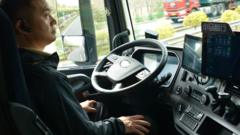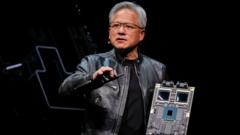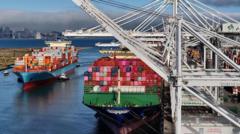In China, driverless trucks are making headlines as they begin to navigate public roads under the watchful eye of safety operators. Companies see potential for improved efficiency and cost savings, while experts caution about public acceptance and technological hurdles. In Hefei, autonomous delivery vans are already linking distribution hubs to neighborhoods, showcasing the possibilities ahead.
The Rise of Driverless Trucks: Transforming China's Logistics Landscape

The Rise of Driverless Trucks: Transforming China's Logistics Landscape
As China embraces autonomous technology, driverless trucks promise to revolutionize the transport industry, though challenges and public skepticism linger.
On the bustling highways between Beijing and Tianjin, autonomous trucks are demonstrating their potential to reshape China's transportation sector. Equipped with advanced self-driving technology, these trucks are currently monitored by safety drivers, though experts predict a future where human oversight may become obsolete. "The first time I let it drive, I was both excited and nervous," reflects Huo Kangtian, a safety driver. "But after enough training and observation, it's clear these machines are quite adept and secure."
Once engaged, the trucks autonomously maneuver through complex road conditions, including toll gates and interchanges. "My primary role is to intervene in emergencies if necessary," explains Mr. Huo, who acknowledges the benefits of working with these trucks—reduced fatigue, and improved productivity. While there is uncertainty about job security, he remains optimistic about the gradual integration of automation in the industry.
Pony AI, a leader in this field, envisions a future where autonomous transport systems improve efficiency, cut labor costs, and excel in challenging driving conditions. Professor Yang Ruigang emphasizes the undeniable appeal of reducing operational expenses, making the investment in driverless technology attractive for logistics firms.
However, the transition to fully autonomous trucking faces hurdles, most notably public concern stemming from past accidents involving self-driving vehicles. Analyst Chim Lee appraises the current climate, suggesting that public perception will significantly affect policy and market dynamics for driverless technology in China.
In Hefei, the Anhui Province capital, city officials have authorized autonomous delivery vans to operate amid bustling human traffic— an initiative fueled by government support and local entrepreneurial spirit. Rino.ai's president, Gary Huang, points to successful trials of delivery systems that seamlessly integrate autonomous vehicles with local couriers for last-mile services. The company's operations have surged, with over 500 autonomous vans currently running across more than 50 cities.
The rapid uptake of technology implies a shift in logistics efficiency, as companies invest in multiple autonomous delivery options rather than hiring a single driver. "This pace is astonishing, and within five years, we may see heavy-duty trucks operating autonomously under specific conditions," reflects Zhang Qichen, Rino's regional director for Anhui Province.
Yet, full-scale implementation of driverless trucks along major highways remains a long-term vision. Industry leaders foresee challenges in integrating complex technological requirements, improving sensing capabilities for heavy lorries, and addressing public concerns regarding safety. The cost of existing retrofitted trucks also presents an economic barrier to widespread adoption.
China is keen to position itself as a pioneer in autonomous technologies, balancing innovation with public perception. This initiative is not just about complying with regulations; it is about fostering a societal understanding of the benefits technology brings. As Professor Yang notes, society may tolerate human error, but trust in machines demands an exceptionally high reliability standard. While the future of driverless trucks in China seems promising, it requires a careful bridging of technology, public confidence, and regulatory measures.
















